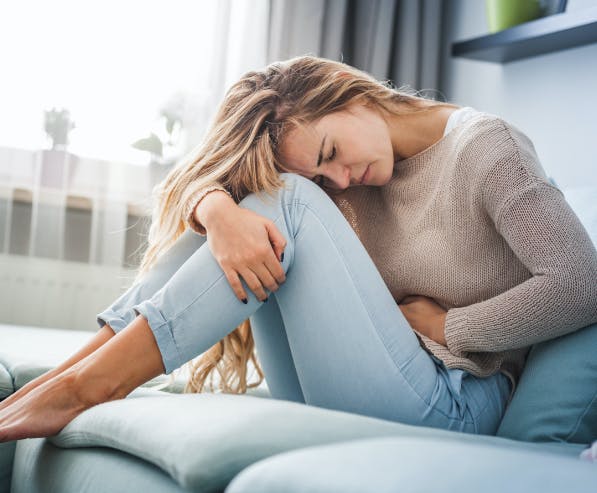What is a medication overdose?
When managing your or your family’s health, including pain management, it’s recommended to start with a conversation with your pharmacist or doctor and always be sure to read and follow the product label.

What is a medication overdose?
We’ve all been there; sometimes painkillers you have taken for a headache or pain feel like they’re not kicking in and you can be tempted to take more than the recommended dose.
To treat pain in the right way, medications should only be used as directed by the product label or by a healthcare professional. Taking too much of a medication like paracetamol is known as a medication overdose and can cause serious side effects and harm to your body.
If you take a pill overdose you should seek medical treatment or advice immediately even if you are not yet experiencing symptoms.
Remember to keep the medicine bottle or packet as healthcare personnel may want to see exactly what you have taken. The effects of a paracetamol overdose include liver damage or liver failure and even death if you do not receive medical help.1
Paracetamol overdoses may be taken intentionally as self-harm, but you may also accidentally exceed recommendations. Paracetamol is commonly found in medicines for pain, fever, symptoms of cold and flu, and sleep medicines. Taking more than one medication with paracetamol at a time increases your chances of accidentally taking too much. It is important to always read the labels on your medications to ensure you know which ones contain paracetamol. Around 100,000 people attend A&E each year in the UK for paracetamol overdoses.2
What is a paracetamol overdose?
The maximum daily dosage of paracetamol for adults is 4000mg. You should always use the lowest dose necessary for the shortest duration possible.3
Paracetamol and caffeine formulations have the same maximum daily dosage for adults4 but one thing to keep in mind is that excessive intake of other forms of caffeine like tea or coffee should be avoided whilst you’re taking them.5
If you’re wondering what happens when you overdose paracetamol, it is important to understand that paracetamol is processed by the liver. Since the liver cannot process large doses of paracetamol, taking an excessive dosage means toxins can build up in your body resulting in liver damage and in some cases death. 6
Liver disease or long term alcohol abuse7 impacts your liver function, so anyone with these issues should talk to a medical professional before using paracetamol.
What are the signs of an overdose on paracetamol?
If you take a paracetamol overdose, you should seek medical advice even if you don’t display any symptoms – this is due to the risk of delayed liver failure.8
There may be no visible signs of overdose from paracetamol, but people commonly experience nausea and vomiting.9
Here’s the signs to watch out for in the days following excessive consumption:10
- Nausea
- Vomiting
- Pain in your upper right abdomen
- Jaundice (yellow discoloration of the skin, mucous membranes, and the whites of the eyes
- Unexpected bleeding as blood clotting is impaired
Due to these risks, you must keep painkillers and other medication out of the reach of children and pets by storing them in a safe place.
How do you treat a paracetamol overdose?
Whether or not you display signs of an overdose, medical professionals can run tests and offer a paracetamol poisoning antidote if necessary. This is most effective when taken within eight hours of the event, which emphasizes the importance of seeking medical advice right way if you think you have taken too much.11
If you or someone you know is treated for a paracetamol overdose, you should tell medical staff the quantity as well as the form of paracetamol taken (e.g. modified release or standard). You should also inform them when it was taken, the method (e.g. swallowed or inhaled) and provide the medication bottle if possible. This can help them develop a treatment plan based on the specific situation. For example, absorption of modified release tablets is slower in the case of an overdose, so high concentrations can also occur later than with standard tablets.12
Your age and weight are also important information that medical staff need to know if you are treated for a painkiller overdose.
Combined painkiller overdoses
Along with making sure you use the recommended dose of painkillers; it is also a must to check the label of any medication that you may be taking in parallel. Many over the counter products to treat coughs or colds also contain paracetamol. Unknowingly taking 2 products that contain paracetamol could cause an unintended overdose.
NSAID overdoses
When using NSAIDs (non-steroidal anti-inflammatory drugs) you should always use the lowest dose necessary for the shortest amount of time.
It is possible to accidentally exceed the recommended dosage for NSAIDs such as diclofenac, ibuprofen and combined formula painkillers like paracetamol, aspirin and caffeine. This is why you should always read the label before using any medication to avoid accidental pill overdoses.

What happens if you overdose NSAIDs?
There are many different strengths and formulations of oral diclofenac and ibuprofen. Therefore, it is important that you read the product information to understand the maximum daily dose for the specific NSAID product you are taking. To avoid a medication overdose you should never exceed this dose.
Symptoms of an oral NSAID overdose can include:14
- Vomiting
- Stomach Bleeding
- Diarrhoea
- Dizziness
- Ringing in ears
- Seizures
Maximum dosage of topical gels
When it comes to diclofenac topical gel, only a small amount is absorbed into the blood stream, but it should always be used as directed to avoid harm to your body. Additionally, if diclofenac gel is intentionally or accidentally swallowed, undesirable effects similar to those observed with oral diclofenac can be expected.
The daily dosage varies based on which gel you use but you should only be applying a cherry to walnut-sized amount for either, depending upon the size of the painful or swollen area.15
Diclofenac gels with a 1.16% concentration should be applied three to four times daily with a cherry to walnut (2g to 4g) sized quantity, depending upon the size of the painful or swollen area.16
Diclofenac gel with a higher 2.32% dosage should be applied twice daily in the morning and evening as it can provide pain relief for up to 12 hours and you should use the same quantity for each dose (2g to 4g).17
How do you treat a NSAID overdose?
If you exceed the recommended dosage of dosage of NSAIDs such as diclofenac or ibuprofen tablets, you should seek medical help immediately as healthcare experts can suggest symptomatic and supportive treatment.
As diclofenac gel is absorbed slowly, it makes a medication overdose via your skin unlikely, but if you accidentally or intentionally swallow the gel you should seek medical treatment immediately. 18
You should use the gel only as directed on the product leaflet/labeling.
Other important information about medication overdoses
When you think of drug overdoses, you probably don’t think of food and beverage interactions. However, some food and drinks can interact with the way medicine is processed in your body, if taken orally. One such example is grapefruit juice.
Many drugs are broken down by enzymes in the small intestine. Grapefruit juice can block the action of an important enzyme responsible for breaking down certain drugs, so instead of being processed the way it is intended, more of the drug enters the blood and stays in the body longer, resulting in too much drug in your body.19
If you consume grapefruit juice, be sure to check with your medical professional about any possible interactions this might have with the drugs you are taking.
This is because citrus fruits such as grapefruit can commonly interact with20:
- Blood pressure medication
- Cholesterol medication
- Anti-anxiety medication
- Painkillers
- Cough medicine
What do you need to know about medication overdoses in children?
For children, recommended paracetamol doses are calculated based on age and weight. Children’s dosage is carefully calculated to help they get the desired therapeutic effect while minimizing the chance of harm.
Along with keeping potentially dangerous medication out of the reach of children, you should also carefully read any information that comes with painkillers and ensure you give children the correct dosage for their weight and age.
Before taking any medicine, including paracetamol, start with a conversation with your healthcare provider.
Whatever’s on your mind, we can put it right. Let’s treat it right.
SHARE THIS ARTICLE
1 Paracetamol Overdose: What You Need to Know, Netdoctor https://www.netdoctor.co.uk/healthy-living/wellbeing/a28355/paracetamol-overdose/ accessed 19.08.21
2 Paracetamol Overdose: What You Need to Know, Netdoctor https://www.netdoctor.co.uk/healthy-living/wellbeing/a28355/paracetamol-overdose/ accessed 19.08.21
2 Paracetamol GDS – p11
4 Paracetamol & Caffeine GDS – p5
5 Paracetamol & Caffeine GDS – p7
6 Paracetamol GDS – p33
7 Paracetamol GDS – P22
8 Paracetamol GDS – P27
9 Paracetamol Overdose Management, NHS, https://hgs.uhb.nhs.uk/wp-content/uploads/Paracetamol-Overdose.pdf accessed 19.08.21
10 Paracetamol Overdose: What You Need to Know, Netdoctor https://www.netdoctor.co.uk/healthy-living/wellbeing/a28355/paracetamol-overdose/ accessed 19.08.21
11 Paracetamol Overdose: What You Need to Know, Netdoctor https://www.netdoctor.co.uk/healthy-living/wellbeing/a28355/paracetamol-overdose/ accessed 19.08.21
12 Paracetamol GDS – P27
13 Paracetamol Overdose: What You Need to Know, Netdoctor https://www.netdoctor.co.uk/healthy-living/wellbeing/a28355/paracetamol-overdose/ accessed 19.08.21
14 Oral Diclofenac GDS – P13
15 Diclofenac 1% Gel, EMC, https://www.medicines.org.uk/emc/product/10950/smpc accessed 19.08.21
16 Topical Diclofenac GDS – P5
17 Topical Diclofenac GDS – P6
18 Topical Diclofenac GDS – P11
19 Grapefruit Juice and Some Drugs don’t Mix, FDA, https://www.fda.gov/consumers/consumer-updates/gr
apefruit-juice-and-some-drugs-dont-mix accessed 19.08.21
20 Consumer Health, Mayoclinic, https://www.mayoclinic.org/healthy-lifestyle/consumer-health/expert-answers/food-and-nutrition/faq-20057918 accessed 19.08.21

Let's treat it right and Panadol
Find out more, including usage and dosage guidance for pain relief treatments, from Panadol.

Let's treat it right and Voltaren
Find out more about the right use of pain relief medicines, including dosing and disposal advice, from Voltaren.



